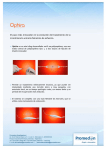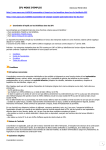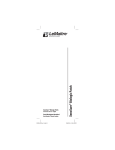Download Manual de usuario
Transcript
M-20-15-0114 (05) TESTICULAR PROSTHESIS User´s Manual ENGLISH PROTHESE TESTICULAIRE Notice D´Utilisation FRANÇAIS HODENPROTHESE Gebreuchsanweisung DEUTSCH PRÓTESIS TESTICULAR Manual del Usuario ESPAÑOL PRÓTESE TESTICULAR Manual do Usuário PORTUGUES PROTESI TESTICOLARE Manuale dell´Utente ITALIANO TEST S PROTEZ Kullanım Kılavuzu TÜRKÇE USER MANUAL DESCRIPTION The Testicular Prosthesis has been designed to replace, through surgery, the natural testicle in shape and size. It is a solid implant made of elastometer of low-hardness silicone, which is very similar to the natural testicle. PRESENTATION IMPLANTS MODEL A (mm) B (mm) T-Small T-Medium T-Large T-XLarge 31 37 42 47 23 28 32 34 A B Sterilization Method: Ethylene Oxide. INDICATIONS Designed as a cosmetic replacement, Testicular Prosthesis is advisable for those patients who had suffered from testicular agenesis, or when the testicle has been removed through surgery due to several pathologies. CONTRAINDICATIONS The prosthesis implant is not recommended if there is infection in some part of the body, particularly if it is genital or in the urinary tract. Testicular Prosthesis cannot be used in patients with neoplasia or transescrotal infection. WARNINGS Patients who undergo surgical operations are liable to complications during and after the surgery. Surgeries associated with the use of testicular implants entail risks or potential complications. Thus, prior to surgery, physicians should inform patients about possible complications related to the use of this prosthesis. This product has been designed for single use. Testicular implants in children is only recommended for cosmetics purposes. Patients must be taught to distinguish the prosthesis from the natural testicle through self-examination. Removal of the prosthesis is advisable in the case of surgical, physical or psychological problems. PATIENT NFORMATION It is the surgeon´s responsibility to inform the patient and/or his representatives, before surgery, about all possible complications related prosthesis implantation. Promedon and its distributors delegate to the surgeon the responsibility of informing the patient about all possible risks and advantages related to prosthesis implantation and usage. PRECAUTIONS Careful patient selection is essential, as well as a thorough diagnostic study before the surgery. The prosthesis must be checked prior to and during the surgery, so as to monitor the structural integrity of the implant. The prosthesis should be handled carefully, avoiding pointed, toothed, or sharp instruments, as any nick or damage may be the cause for subsequent complications of the implant. Dirt, fingerprints, talc or any other substances that can contaminate the surface of the prosthesis may be the cause of reactions to foreign objects. Extreme preventive measures must be taken to avoid contamination. Any hole or mark in the prosthesis is a possible cause of failure, since it may serve as a surface to keep materials that may cause reactions to foreign objects or infections in the patient. The prosthesis is supplied sterile and pyrogen free in a double-wrap packaging system. This packaging is contained into a cardboard box wrapped with a thermocontrible foil which must be undamaged.IF IT WAS DAMAGED WHEN HANDLING, THE PROSTHESIS SHOULD NOT BE IMPLANTED. Operating room conditions: In general, operating rooms meet the requirements for testicular implant surgery. Nevertheless, we strongly recommend checking the following parameters: • Operating room asepsis. • Adequate training for the surgical support personnel. COMPLICATIONS Possible complications associated with the use of this prosthesis must be discussed with the patient prior to surgery. Complications which may result from the use of this prosthesis include the risks associated with the medication and methods utilized in the surgical procedure, as well as the patient’s degree of intolerance to any foreign body. Some complications may demand prosthesis removal. Pain or fever indicating infection may appear after the implantation. Infections that do not respond to antibiotic therapy demand prosthesis removal. Dermic necrosis or wound opening may appear as a result of: an inadequate tension of the skin covering the implant, a trauma of skin surface during surgery or an inadequate circulating inhibition of the tissue. Subsequent extrusion of the implant may be necessary after this. Post-surgical hematoma, seen as a swelling and tissue color fading, may cause extrusion of the device, if it not treated appropriately. Excessive fluid accumulation around the implant may be produced after surgery, as a result of traumas. Prosthesis size, wrong placing or migration may cause unsatisfactory cosmetic results. The post-surgical formation of a fibrous tissue capsule surrounding the testicular prosthesis is a normal physiological reaction to the implantation of a foreign body. If the patient feels discomfort, pain, throbbing of heart or prosthesis movement, the implant must be removed. Surgeons should inform Promedon S.A. or Promedon´s distributor about any complication associated with the use of this prosthesis. SURGICAL APPROACH Although the recommended approach is via inguinal, the surgeon should choose the most convenient approach for each particular case. In the case of patient with unilateral agenesia, the date of implantation should be defined by the surgeon. When orchiectomy is required, ablation and implant are performed during the same surgery. In those patients with testicular tumours, cord torsion, atrophic testicles or elderly patients with inguinoscrotal hernia, just one surgical act is performed. In the case of patients with trausmatisms, it is advisable that the surgeon try a reconstruction withouth implant. However, if the results is negative, the surgeon should implant the prosthesis. In case of castration for prostatic carcinoma, the surgeon should choose the most convenient approach for each patient, but it is common to implant the prosthesis during the same surgery. It is for the own judgement of the surgeon to decide to fix the prosthesis or not. In case he fixes ir, he has to pass thre suturing material of his preference through whichever point of the prosthesis, since its solid design avoids leakage risks. However, we suggest that a minimal distance of 5 mm from the extreme of the prosthesis should be respected so as to avoid the prosthesis breakage. The bibliography mentioned bellow could help surgeons to get acquainted with the techniques. REFERENCES • Michael Beer, M.D., and Robert Kay, M.D., Testicular Protheses, Urologic Clinics of North America - Vol. 16, Nº 1, February1989, pages 133 to 138. • Joseph Ortengerg, M.D., and Robert G. Kujpper, M.D., “The Why and How of Synthetic Replacement Testicles”, Contemporary Urology, October 1991, pages 23 to 32. SYMBOLS USED IN THE LABELS CATALOGUE NUMBER BATCH NUMBER SEE INSTRUCTIONS FOR USE EXPIRATION DATE DO NOT REUSE DATE OF MANUFACTURE STERILE: STERILIZATION METHOD ETHYLENE OXIDE MANUFACTURER AUTHORIZED REPRESENTATIVE IN THE EUROPEAN COMMUNITY NOTICE D’UTILISATION DESCRIPTION La prothèse testiculaire est un implant qui a étè conçu pour remplacer en taille et forme le testicule naturel, par l’implantation chirurgicale. C’est un implant solide, fabriqué en élastomère de silicone de faible dureté, qui donne à la prothèse une consistence semblable à celle du testicule naturel. PRESENTATION IMPLANTS REFERENCE A (mm) B (mm) T-Small T-Medium T-Large T-XLarge 31 37 42 47 23 28 32 34 A B Mode de stérilisation: oxyde d’eéthylène. INDICATIONS La prothèse testiculaire est indiquée en chirurgie esthétique en cas d’ agénésie testiculaire ou suite à l’ablation chirurgicale du testicule ou à cause de différentes pathologies. CONTRE-INDICATIONS L’implantation d’une prothèse n’est pas indiquée en présence d’une quelconque infection, particulièrement, au niveau génital ou dans les voies urinaires. La prothèse testiculaire ne doit pas être posée chez des patients atteints de néoplasie ou d’infection du scrotum. AVERTISSEMENT Tout patient, se soumettant à une intervention chirurgicale, est exposé à des complications opératoires et post-opératoires. La procédure chirurgicale rattachée à l’utilisation d’implants testiculaires compofrte toujours des risques ou complications potentiels. Aussi, avant l’intervention chirurgicale, il incombe au chirurgien d’informer le patient des possibles réactions et complications associées à l’usage des prothèses. Ce produit a été conçu pour une seule utilisation. Il faut apprendre aux patients à distinguer la prothèse du testicule naturel au par l’auto-examen. En cas de problèmes chirurgicaux, de troubles physiques ou psychologiques, il est recommandé d’extraire la prothèse. INFORMATION DU PATIENT Il est de la responsabilité du chirurgien d’informer les patients et/ou ses représentants, avant l’operation, des complications possibles associées à la pose de la prothèse. Promedon et son distributeur délèguent au chirurgien la responsabilité de donner au patient toutes les informations sur les risques et les bénéfices d’une telle intervention. PRECAUTIONS Une sélection scrupuleuse du patient est essentielle ainsi que la réalisation d’examens approfondis avant l’intervention. La prothèse doit être vérifiée avant l’intervention et continuellement contrôlèe pendant l’acte chirurgical afin de s’assurer de son intégrité structurelle. On doit manipuler la prothèse avec précaution, en évitant les objets pointus, dentés ou effilés. La poussière, des empreintes digitales, du talc ou toute substance pouvent contaminer la surface de la prothèse et devenir la cause de réactions à des corps étrangers. Les plus grandes précautions doivent être prises pour éviter toute contamination. Une quelconque marque ou aspérité sur la prothèse est une cause potentielle d’échec. En effet, des impuretés peuvent se loger dans ces cavités et augmenter le risque d’infection ou de rejet lié à la présence d’un corps étranger. La prothèse est délivrée stérilisée et sans pyrogène dans un double blister, à l’intérieur d’une boite en carton, scellée par un film thermocontractile. SI L’EMBALLAGE A ETE ENDOMMAGE, LA PROTHESE NE DOIT PAS ETRE IMPLANTEE. Conditions de la salle d’operation: en général, toutes les salles d’operation réunissent les conditions nécessaires pour le pratiquer la pose de la prothèse. Cepedant, il est recommandé de veiller tout particulièrement aux aspects suivants: • Asépsie de la salle d’opération. • Formation appropriée des assistants de la salle d’operation. COMPLICATIONS Les possibles complications associées à l’utilisation de la prothèse doivent être discutées avec le patient avant l’intervention. Les complications qui peuvent survenir suite à l’implantation de cette prothèse incluent les risques associés à la médication et aux méthodes utilisées durant la procédure chirurgicale ainsi que le niveau de tolérance du patient aux corps étrangers. Quelques complications peuvent rendre l’extraction de la prothèse nécessaire. Des infections manifestées par la douleur ou la fièvre peuvent apparaître après l’intervention. Si l’infection ne disparaît pas après un traitement aux antibiotiques, il est indiquée d’extraire la prothèse. Il peut se produire des nécroses dermiques ou un écartement de la cicatrice dû à la tension exercée par l’implant sur la peau ou des traumatismes survenus sur les tissus lors d l’intervention. L’extraction de l’implant peut s’avérer nécessaire. L’hématome post-opératoire se traduisant par un gonflement et une décoloration du tissu peut occasionner, si ce n’est pas traité, l’extraction de la prothèse. Il peute se produire une accumulation post-opéraratoire excessive de liquide près de l’implant comme résultat d’un traumatisme. Une taille non appropiée, une mauvaise mise en place ou la migration de l’implant peuvent empêcher un résultat esthétique satisfaisant. La formation post-opératoire d’une coque fibreuse autour de la prothèse testiculaire est une réaction pshysiologique normale à la présence d’un corps étranger. Si le patient ressent un désagrément, une douleur, des palpitations ou un déplacement de la prothèse, la prothèse devra être retirée. Les chirurgiens doivent informer Promedon ou ses distributeurs de toute complication pouvant se développer lors de l’utilisation de la prothèse. ABORD CHIRURGICAL Bien que l’abord recommandé est la voie inguinale, le chirurgien doit choisir l’abord le plus adapté à chaque cas. En cas d’ agénésie unilatérale, la date d l’implantation est décidée librement par le chirurgien. En cas d’orchitectomie, l’ablation et l’implantation se font au cours de la même intervention. Chez des patients ayant des tumeurs testiculaires, des torsions de cordon, des testicules atrophiés ou chez des patients âgés avec des hernies inguinoscrotales, un seul acte est pratiqué. Pour les patients avec des traumatismes, il est recommandé que le chirurgien tente la reconstruction sans implant. Cependant, si le résultat est négatif, le chirurgien devrait implanter la prothèse. En cas de castration par carcinome de la prostate, le chirurgien choisira l’abord le plus approprié à chaque patient mais il est courant d’implanter la prothèse au cours de la même intervention. Il revient au chirurgien la décision de fixer ou pas la prothèse. S’il la fixe, il peut passér la suture de son choix par n’importe quel point de la prothèse, étant donné qu’elle est solide et ne présente aucun risque de fuite de liquide. Cepedant, il est recommandé qu’une distance minimale de 5 mm de l’extrémité de la prothèse soit respectée afin d’éviter sa rupture. La bibliographie ci-après peut aider les chirurgiens à se familiariser avec les techniques. REFERENCES • Michael Beer, M.D., and Robert Kay, M.D., Testicular Protheses, Urologic Clinics of North America - Vol. 16, Nº 1, février 1989, pages 133 à 138. • Joseph Ortengerg, M.D., and Robert G. Kujpper, M.D., “The Why and How of Synthetic Replacement Testicles”, Contemporary Urology, octobre 1991, pages 23 à 32. SYMBOLES UTILISÉS SUR LES ÉTIQUETTES NUMÉRO DE CATALOGUE NUMÉRO DE LOT VOIR NOTICE D’UTILISATION DATE DE PÉREMPTION NE PAS RÉUTILISER DATE DE FABRICATION STÉRILE. MÉTHODE DE STÉRILISATION: OXYDE D’ÉTHYLÈNE FABRICANT REPRÉSENTANT AUTORISÉ DANS LA COMMUNAUTÉ EUROPÉENNE GEBRAUCHSANWEISUNG DESCRIPTION Die Hodenprothese ist ein Implantat, das entworfen wurde, um durch eine chirurgische Implantation den natürlichen Hoden in Form und Größe zu ersetzen. Es handelt sich um ein festes, aus Silikonelastomeren geringer Härte gefertigtes Element, das eine ähnliche Beschaffenheit hat, wie der natürliche Hoden. AUSFÜHRUNGEN IMPLANTATE MODELL A (mm) B (mm) T-Small T-Medium T-Large T-XLarge 31 37 42 47 23 28 32 34 A B Sterilisierungsmethode: Äthylenoxyd. INDIKATIONEN Die Hodenprothese wurde entwickelt, um als ästhetischer Ersatz durch chirurgische Implantation bei Patienten eingesetzt zu werden, die an Hodenagenesie leiden, oder denen aufgrund verschiedenster Pathologien der Hoden schon entfernt wurde oder werden soll. GEGENANZEIGEN Die Implantation einer Prothese ist nicht zu empfehlen bei einer Infektion in irgendeinem Körperteil, insbesondere im Genital- oder im Harnbereich. Die Hodenprothese darf nicht bei Patienten verwendet werden, bei denen Gewebsneubildung in der Anamnese auftritt, oder wenn sich eine transskrotale Infektion andeutet. WARNUNGEN Bei jedem Patienten, der sich einem chirurgischen Eingriff aussetzt, besteht die Möglichkeit uner- wünschter operativer und postoperativer Komplikationen. Ein chirurgischer Eingriff in Verbindung mit dem Gebrauch von Hodenimplantaten bedeutet immer ein gewisses Risiko oder die Möglichkeit einer Komplikation. Deshalb liegt es in der Verantwortung des Chirurgen, den Patienten vor dem chirurgischen Eingriff über die möglichen Reaktionen und Komplikationen beim Gebrauch der Prothese aufzuklären. Dieses Produkt wurde für nur einmaligen Gebrauch entwickelt. Den Patienten muß beigebracht werden, durch Selbstuntersuchung die Prothese vom natürlichen Hoden zu unterscheiden. Bei chirurgischen, physischen oder psychologischen Problemeb wird die Entnahme der Prothese empfohlen. PATIENTENINFORMATION Es liegt in der Verantwortung des Chirurgen, den Patienten oder seine Vertreter vor der Chirurgie über die möglichen Risiken im Zusammenhang mit der Implantation zu informieren. Promedon und seine Vertreter übertragen dem Chirurgen die Verantwortung, den Patienten über die Vorteile und möglichen Risiken bei der Implantaion der Prothese und dem Gebrauch aufzuklären. VORSICHTSMASSNAHMEN Die wesentlichsten Vorsichtsmaßnahmen sind eine sorgfältige Auswahl des Patienten und die Durchführung der notwendigen vorhergehenden Untersuchungen. Die Prothese muß vor und während des chirurgischen Eingriffes ständig überprüft werden, um die strukturelle Integrität des Implantats sicherzustellen. Die Prothese muß mit Vorsicht gehandhabt werden; spitze, gezahnte oder scharfe Gegenstände sind zu vermeiden. Fusseln, Fingerabdrücke, Puder oder andere Elemente, die die Oberfläche der Prothese verschmutzen, können der Grund für Reaktionen auf Fremdkörper sein. Es müssen höchste Vorsichtsmaßnahmen ergriffen werden um Verunreinigungen zu vermeiden. Jedes loch oder jeder oberflächliche Fleck auf der Prothese ist ein möglicher Grund für einen Fehlschlag, weil sich dort eine Fläche mit Material bilden kann, welches Reaktionen auf Fremdkörper beim Patienten zur Folge haben oder der Grund für Infektionen sein kann. Die Prothese wird sterilisiert un frei von Pyrogen in einer doppelten Verpackung geliefert. Diese Verpackung befindet sich in einer Kartonschachtel mit einer thermokontrahibelen Verpackung. FALLS DIESE BESCHÄDIGT IST, DARF DIESE PROTHESE NICHT IMPLANTIERT WEDEN! Bedingungen im Operationssaal: Im allgemeinen bestehen in allen Operationssälen die notwendigen Bedingungen für eine Prothesenimplantation. Folgende Parameter sollten jedoch beachtet werden: • Asepsis des Operatonssaales. • Angemessene Ausbildung des Hilfspersonals im Operationssaal. KOMPLIKATIONEN Die möglichen Komplikationen beim Gebrauch der Prothese müssen mit dem Patienten vor der Chirurgie besprochen werden. Die Komplikationen, die sich aus dem Gebrauch dieser Prothese ergeben, beinhalten die Risiken im Zusammenhang mit der Medikamentation und den Methoden der chirurgischen Durchführung, sowie die Reaktion des Patienten oder den Grad der Unverträglichkeit eines in den Körper Implantierten Fremdkörpers. Einige Komplikationen können eine Prothesenentnahme notwendig machen. Es können Infektionen auftreten, die sich durch Schmerzen oder Fieber nach der Implantation äußern. Infektionen, die nicht auf eine Behandlung mit Antibiotika ansprechen, machen eine Entnahme der Prothese notwendig. Es können eine Hautneurose oder eine Öffnung der Wunde aus folgenden Gründen auftreten: ungerechtfertitge Spannung der Haut, die das Implantat bedeckt, Trauma der Hautoberfläche während des chirurgischen Eingriffes oder eine unangemessene Zirkulation im Gewebe. In der Folge kann es zu einer Extrusion des Implantats kommen. Das postoperative Hämatom, das sich durch Vergrößerung und Verfärbung des Gewebes äußert, kann, wenn es nicht behandelt wird, zur Extrusion der Vorrichtung führen. Es ist möglich, daß es nach der Operation aufgrund der Traumata im Implantationsbereich zu einer übermäßigen Ansammlung von Flüssigkeit um die Prothese herum kommt. Eine unangemessene Implantatsgröße, eine falsche Lokalisierung oder eine Abwanderung des Implantats sind Faktoren, die ein befriedigendes ästhetisches Ergebnis stören können. Die postoperative Bildung einer Kapsel aus fibrösem Gewebe um die Hodenprothese herum ist eine normale physiologische Antwort auf die Implantation eines Fremdkörpers. Falls es beim Patienten zu Beschwerden, Schmerzen, Palpitationen oder Verschieben der Prothese kommt, muß diese wieder verschoben werden. Promedon fordert die Chirurgen auf, jede Komplikation die durch den Gebrauch dieser Prothese entstehen kann, der Kompanie Bescheid zu geben. CHIRURGISCHER ZUGANG Der Chirurg sollte den Weg wählen, den er für den jeweiligen Fall am angemessensten hält. Der empfohlene Zugang ist über den Leistenkanal. In den eiseitigen Fällen von Agenesie kann der Zeitpunkt für die Implantation vom Chirurg frei gewählt werden. In den Fällen von Patienten, bei denen eine Hodenextirpation nötig ist, werden die Ablation und die Implantation in der gleichen Chirurgie durchgeführt. Dieselbe Vorgehensweise eines einzigen chirurgischen Aktes wird bei Patienten mit Hodentumoren, Strangtorsionen, atrophischen Hoden oder bei älteren Patienten mit inginaler Skrotalhernie gewählt. Bei Patienten mit Traumatismen versucht der Chirurg gewöhnlich eine Rekonstruktion ohne Implantat. Ist das Ergebnis negativ wird eine Prothese implantiert. In den Fällen von Kastration aufgrund eines Protatakarzinoms wählt der Chirurg den für den jeweiligen Patienten günstigsten Zugangsweg. Gewöhnlich wird die Implantation während der gleichen Chirurgie durchgeführt. Der Chirurg entscheidet darüber, ob er die Prothese befestigt oder nicht. Falls er sich dafür entscheidet, kann er das Nähmaterial seiner Wahl durch einen beliebigen Punkt der Prothese führen, da durch die Festigkeit derselben kein Risiko eines Flüssigkeitsverlustes besteht. Wir empfehlen, daß sich dieser Punkt in einer minimalen Entfernung von 5 mm vom Extrem der Prothese befindet, um eine Beschädigung derselben zu vermeiden. Die Chirurgen können sich mi unten genannter Literatur über die Techniken informieren. LITERATURANGABEN • Michael Beer, M.D., und Robert Kay, M.D., Testicular Protheses, Urologic Clinics of North America - Vol. 16, Nº 1, Februar 1989, S.133 - 138. • Joseph Ortengerg, M.D., und Robert G. Kujpper, M.D., “The Why and How of Synthetic Replacement Testicles”, Contemporary Urology, Oktober 1991, S. 23 - 32. ETIKETTENSYMBOLE KATALOGNUMMER PARTIENUMMER SIEHE GEBRAUCHSANWEISUNGEN FÄLLIGKEITSDATUM KEINE NEUVERWENDUNG HERSTELLUNGSDATUM STERIL DURCH ETHYLENOXID HERSTELLER HANDELSVERTRETUNG IN DER EU MANUAL DE USO DESCRIPCIÓN La prótesis testicular es un implante que ha sido diseñado para reemplazar, mediante implantación quirúrgica, al testículo natural en forma y tamaño. Es un elemento sólido, fabricado en elastómetro de silicona de baja dureza, que permite a la prótesis tener una consistencia similar al testículo natural. PRESENTACIÓN IMPLANTES MODELO A (mm) B (mm) T-Small T-Medium T-Large T-XLarge 31 37 42 47 23 28 32 34 A B Método de esterilización: Oxido de Etileno. INDICACIONES La prótesis testicular ha sido desarrollada para ser utilizada como reemplazo estético, mediante implantación quirúrgica, en aquellos pacientes que hayan sufrido agénesis del testículo o que, por distintas patologías, ya se les haya extraído o necesiten la extirpación de su testículo. CONTRAINDICACIONES El implante de una prótesis no es indicado si existe infección en alguna parte del cuerpo, particularmente si es genital o del tracto urinario. La prótesis testicular no debe ser utilizada en pacientes con antecedentes de neoplasia, o si se evidencia infección transescrotal. ADVERTENCIAS Cualquier paciente que se someta a un procedimiento quirúrgico está sujeto a complicaciones operato- rias y postoperatorias no deseadas. El procedimiento quirúrgico asociado con el uso de implantes testiculares conlleva siempre algún riesgo o complicación potencial. Por lo tanto, es responsabilidad del cirujano informar al paciente, antes de la intervención quirúrgica, sobre las posibles reacciones y complicaciones relacionadas con el uso de las prótesis. Este producto ha sido desarrollado para un solo uso. Los pacientes deben ser instruidos sobre cómo se distingue la prótesis del testículo natural mediante la autoexaminación. Ante la presencia de problemas quirúrgicos, físicos o psicológicos, se recomienda la extracción de la prótesis. INFORMACIÓN AL PACIENTE Es responsabilidad del cirujano informar al paciente o a sus representantes antes de la cirugía sobre las posibles complicaciones relacionadas con la implantación de la prótesis. Promedon y sus distribuidores delegan al cirujano la responsabilidad de informar al paciente sobre las ventajas y posibles riesgos relacionados con la implantación de la prótesis y su uso. PRECAUCIONES La principal precaución es una adecuada selección del paciente y la realización de los estudios previos necesarios. La prótesis debe ser chequeada antes de la cirugía, y monitoreada continuamente durante todo el procedimiento quirúrgico para asegurar la integridad estructural del implante. Se debe manipular la prótesis con cuidado, evitando los objetos con puntas, dentados o filosos. Pelusas, huellas digitales, talco u otros elementos que puedan contaminar la superficie de la prótesis pueden ser la causa de reacciones a cuerpos extraños. Se deben tomar las máximas medidas de precaución para evitar contaminaciones. Cualquier orificio o marca superficial en la prótesis es una potencial causa de fracaso porque puede servir para formar una superficie donde se alojen materiales y consecuentemente causar reacciones a cuerpos extraños en el paciente, así como ser la causa de infecciones. La prótesis es provista esterilizada y libre de pirógeno, en packaging de doble envoltorio. Este packaging está colocado dentro de una caja de cartón con un envoltorio termocontraíble. SI ESTE ENVOLTORIO ESTUVIERA DAÑADO, SE RECOMIENDA NO IMPLANTAR LA PRÓTESIS. Condiciones del quirófano: en general, todas las salas de operaciones reúnen las condiciones necesarias para realizar la implantación de la prótesis. Sin embargo, se recomienda controlar los siguientes parámetros: • Asepsis del quirófano. • Entrenamiento adecuado del personal ayudante de quirófano. COMPLICACIONES Las posibles complicaciones asociadas con el uso de la prótesis deben ser discutidas con el paciente antes de la cirugía. Las complicaciones que pueden resultar del uso de esta prótesis incluyen el riesgo asociado con la medicación y los métodos utilizados en el procedimiento quirúrgico, así como también la reacción del paciente o grado de intolerancia a cualquier objeto extraño implantado en el cuerpo. Algunas complicaciones pueden requerir la extracción de la prótesis. Pueden aparecer infecciones manifestadas por dolor o fiebre después de realizarse el implante. Las infecciones que no responden a una terapia de antibióticos requieren la extracción de la prótesis. Se puede producir necrosis dérmica o separación de la herida como resultado de: la indebida tensión de la piel que cubre el implante; trauma de la superficie dérmica durante el procedimiento quirúrgico o una inadecuada circulación en el tejido.Subsecuentemente puede existir la extrusión del implante. El hematoma postoperatorio, manifestado por medio de agrandamiento y decoloración del tejido, puede ocasionar, si no es tratado, la extrusión del dispositivo. Es posible que se produzca una acumulación excesiva de fuidos alrededor de la prótesis durante el postoperatorio debido a traumas en la zona del implante. Una inadecuada selección del tamaño del implante, su incorrecta ubicación o la migración del mismo son factores que pueden interferir con los resultados estéticos satisfactorios. La formación postoperatoria de una cápsula de tejido fibroso alrededor de la prótesis testicular es una respuesta fisiológica normal a la implantación de un objeto extraño. En el caso de que el paciente sienta molestias, dolor, palpitaciones o desplazamiento de la prótesis, se deberá remover la misma. Promedon requiere que los cirujanos notifiquen a la Compañía cualquier complicación que se desarrolle con el uso de esta prótesis. ABORDAJE QUIRÚRGICO El cirujano debe utilizar la vía que más crea conveniente para cada caso. El abordaje recomendado es por vía inguinal. En los casos unilaterales de la agenesia, la fecha de implante es definida por el cirujano con libertad. En los casos de pacientes que requieran orquictomía, se realizan la ablación y el implante en un mismo tiempo quirúrgico. El mismo procedimiento de un solo acto quirúrgico se realiza en aquellos pacientes con tumores testiculares, torsiones de cordón, testículos atróficos o en aquellos pacientes añosos con hernias inguinoescrotales. En aquellos pacientes con traumatismos, es habitual que el cirujano intente la reconstrucción sin implante. En caso de resultado negativo se procederá al implante protésico. En aquellos casos de castración por carcinoma de próstata, el cirujano optará por la vía de abordaje más conveniente para cada paciente. Es habitual que se haga el implante en el mismo tiempo quirúrgico. Queda a criterio del cirujano si fija o no la prótesis. En caso de hacerlo, lo podrá realizar pasando el material de sutura de su preferencia por cualquier punto de la prótesis, ya que por su solidez no tiene riesgo de pérdida de líquido. Sugerimos que este punto respete una distancia mínima de 5 mm desde el extremo de la prótesis para evitar la ruptura de la misma. Los cirujanos pueden informarse sobre las técnicas con la bibliografía que se menciona a continuación. REFERENCIAS • Michael Beer, M.D., and Robert Kay, M.D., Testicular Protheses, Urologic Clinics of North America - Vol. 16, Nº 1, Febrero1989, páginas 133 a 138. • Joseph Ortengerg, M.D., and Robert G. Kujpper, M.D., “The Why and How of Synthetic Replacement Testicles”, Contemporary Urology, Octubre 1991, páginas 23 a 32. SÍMBOLOS UTILIZADOS EN LAS ETIQUETAS NÚMERO DE CATÁLOGO NÚMERO DE LOTE VER INSTRUCCIONES DE USO FECHA DE CADUCIDAD NO REUTILIZAR FECHA DE FABRICACIÓN ESTÉRIL. MÉTODO DE ESTERILIZACIÓN: ÓXIDO DE ETILENO FABRICANTE REPRESENTANTE AUTORIZADO EN LA COMUNIDAD EUROPEA MANUAL DE USO DESCRIÇÃO A prótese testicular é um implante que foi desenhado para substituir, mediante implantação cirúrgica, ao testículo natural em forma e tamanho. É um elemento sólido, fabricado em elastômetro de silicone de baixa dureza, que permite à prótese ter uma consistência similar ao testículo natural. APRESENTAÇÃO IMPLANTES MODELO A (mm) B (mm) T-Small T-Medium T-Large T-XLarge 31 37 42 47 23 28 32 34 A B Método de esterilização: Óxido de Etileno. INDICAÇÕES A prótese testicular foi desenvolvida para ser utilizada como substituição estética, por meio de implantação cirúrgica naqueles pacientes que tenham sofrido agêneses do testículo ou que, por distintas patologias, já tenham extraído ou necessitam a extirpação de seu testículo. CONTRA-INDICAÇÕES O implante de uma prótese não é indicado se existe infeção em alguma parte do corpo, particularmente se é genital ou do trato urinario. A prótese testicular não deve ser utilizada em pacientes com antecedentes de neoplasia, ou se evidencia infeção transescrotal. ADVERTÊNCIAS Qualquer paciente que se submeta a um procedimento cirúrgico está sujeito a complicações operatórias e pós-operatorias não desejadas. O procedimento cirúrgico associado com o uso de implantes testiculares carrega sempre algum risco ou complicação potencial. Portanto, é responsabilidade dol cirurgião informar ao paciente, antes da intervenção cirúrgica, sobre as possíveis reações e complicações relacionadas com o uso das próteses. Este produto foi desenvolvido para um só uso. Os pacientes devem ser instruídos sobre cómo se distingue a prótese dos testículos naturais mediante a auto-examinação. Ante a presenáa de problemas cirúrgicos, físicos ou psicológicos, recomenda-se a extração da prótese. INFORMAÇÃO AO PACIENTE É responsabilidade do cirurgião informar ao paciente ou a seus representantes antes da cirurgia sobre as possíveis complicações relacionadas com a implantação da prótese. Promedon e seus distribuidores delegam ao cirurgião a responsabilidade de informar ao paciente sobre as vantagens e possíveis riscos relacionados à implantação da prótese e seu uso. PRECAUÇÕES A principal precaução é uma adequada seleção do paciente e a realização dos estudos prévios necessários. A prótese deve ser checada antes da cirurgia, e monitorada continuamente durante todo o procedimento cirúrgico para assegurar a integridade estrutural do implante. Deve-se manipular a prótese com cuidado, evitando os objetos com pontas, dentados ou afiados. Penugens, marcas digitais, talco ou outros elementos que possam contaminar a superfície da prótese podem ser a causa de reações a corpos estranhos. Deve-se tomar as máximas medidas de precaução para evitar contaminações. Qualquer oco ou mar superficial na prótese é uma potencial causa de fracasso porque pode servir para formar uma superfície onde se alojem materiais e consequentemente causar reações a corpos estranhos no paciente, assim como ser a causa de infeções. A prótese é fornecida esterilizada e livre de pirogênio em packaging de duplo envoltório. Este packaging está colocado dentro de uma caixa de papelão com um envoltório termocontraível. SE ESTE ESTIVER DANIFICADO, RECOMENDA-SE Não IMPLANTAR A PRÓTESE. Condições da sala de cirurgia: em geral, todo centro cirúrgico reúne as condições necessárias para realizar a implantação da prótese. Con tudo, recomenda-se controlar os seguintes parâmetros: • Assepsia da sala de cirurgia. • Treinamento adequado aos auxiliares de cirurgia. COMPLICAÇÕES As possíveis complicações associadas com o uso da prótese devem ser discutidas com o paciente antes da cirurgia. As complicações que podem ser resultantes do uso desta prótese incluem o risco associado com a medicação e os métodos utilizados no procedimento cirúrgico, assim como também a reação do paciente ou grau de intolerância por qualquer objeto estranho implantado no corpo. Algumas complicações podem requerer a extração da prótese. Podem aparecer infeções manifestadas por dor ou febre depois de realizar-se o implante. As infeções que não respondem a uma terapia de antibióticos requerem a extração do implante. Pode-se produzir necrose dérmica ou separação da ferida como resultado de: a indevida tensão da pele que cobre o implante; trauma da superfície dérmica durante o procedimento cirúrgico ou uma inadequada circulação no tecido. Consequentemente pode ocorrer a extrusão do implante. O hematoma pós-operatório, manifestado por meio de aumento e descoloração do tecido pode ocasionar, se não for tratado, a extrusão do dispositivo. É possível que se produza uma acumulação excessiva de fuidos ao redor da prótese durante o pós-operatório devido a traumas na zona do implante. Uma inadequada seleção ol tamanho do implante, sua incorreta localização ou a migração do mesmo são fatores que podem interferir com os resultados estéticos satisfatórios. A formação pós-operatória de uma cápsula de tecido fibroso ao redor da prótese testicular é uma resposta fisiológica normal â implantação de um objeto estranho. No caso de que o paciente sinta moléstias, dor, palpitações ou deslocamento da prótese, será preciso remover a mesma. A Promedon requer que os cirurgiões comuniquem à Companhia qualquer complicação que se desenvolva com o uso desta prótese. ABORDAGEM CIRÚRGICO O cirurgião deve utilizar a via que considere mais conveniente para cada caso. A abordagem recomendado é por via inguinal. Nos casos unilaterais de agenesia, a data de implante é definida pelo cirurgião com liberdade. Nos casos de pacientes que requeiram orquiectomia, realizam-se a ablação e o implante em um mesmo tempo cirúrgico. O mesmo procedimento de um só ato cirúrgico realiza-se naqueles pacientes com tumores testiculares, torsões de cordão, testículos atróficos o naqueles pacientes idosos com hérnias inguinoescrotais. Naqueles pacientes com traumatismos, é habitual que o cirurgião tente a reconstrução sem implante. Em caso de resultado negativo, o procedimento será o implante protésico. Naqueles casos de castração por carcinoma de próstata,o cirurgião optará pela via de abordagem mais conveniente para cada paciente. É habitual que se faça o implante ao mesmo tempo cirúrgico. Fica a critério do cirurgião se fixa ou não a prótese. Em caso de fazê-lo, poderá ser feito passando o material de sutura de sua preferência por qualquer ponto da prótese, já que por sua solidez não tem risco de perda de líquido. Sugerimos que este ponto respeite uma distância mínima de 5 mm desde o extremo da prótese para evitar a ruptura da mesma. Os cirurgiões podem informar-se sobre as técnicas com a bibliografia relacionada abaixo. REFERÊNCIAS • Michael Beer, M.D., and Robert Kay, M.D., Testicular Protheses, Urologic Clinics of North America - Vol. 16, Nº 1, Fevereiro1989, páginas 133 a 138. • Joseph Ortengerg, M.D., and Robert G. Kujpper, M.D., “The Why and How of Synthetic Replacement Testicles”, Contemporary Urology, Outubro 1991, páginas 23 a 32. . SÍMBOLOS UTILIZADOS NAS ETIQUETAS NÚMERO DE CATÁLOGO NÚMERO DE LOTE VIDE INSTRUÇÕES DE USO DATA DE VALIDADE NÃO REUTILIZAR DATA DE FABRICAÇÃO ESTÉRIL. MÉTODO DE ESTERILIZAÇÃO:ÓXIDO DE ETILENO FABRICANTE REPRESENTANTE AUTORIZADO NA COMUNIDADE EUROPÉIA MANUAL DELL'UTENTE DESCRIZIONE La protesi testicolare è stata disegnata per sostituire attraverso un impianto chirurgico il testicolo naturale nella sua forma e dimensione. Si tratta di un elemento solido costituito di un elastomero di silicone a bassa durezza con una consistenza simile a quella del testicolo naturale. PRESENTAZIONE IMPIANTI MODELLO A (mm) B (mm) T-Small T-Medium T-Large T-XLarge 31 37 42 47 23 28 32 34 A B Metodo di sterilizzazione: Ossido di Etilene. INDICAZIONI La protesi testicolare è stata sviluppata come sostituzione estetica, da utilizare mediante un intervento chirurgico, in quei pazienti che abbiano sofferto di agenesia del testicolo o che, per diverse patologie, abbiano perso un testicolo o abbiano necessità di asportarlo. CONTROINDICAZIONI L’impianto di una protesi non è indicato in caso di infezioni specie se localizzate nella zona genitale o urinaria. La protesi testicolare non deve essere impiegata in pazienti con preecedenti neoplasie o con infezione transcrotale. AVVERTENZE Qualsiasi paziente che decida di sottoporsi ad un intervento chirurgico è soggetto ad eventuali compli- cazioni operatorie e post-operatorie non desiderate. La procedura chirurgica, associata ad un impianto testicolare, presenta comunque una possibilitá di rischio o di una potenziale complicazione. E’ perciò responsabilità del chirurgo informare il paziente, prima dell’intervento, circa le possibili reazioni e complicazioni legate all’uso della protesi. Il prodotto è monouso. I paziente deve essere istruito per poter distinguere la protesi dal testicolo naturale attraverso l’autopalpazione. Se si presentano problemi chirurgici, fisci o psicologici, si raccomanda l’espianto della protesi. INFORMAZIONI PER IL PAZIENTI E’ responsabilità del chirurgo informare il paziente o i suoi rappresentanti prima dell’intervento sulle possibili complicazioni legate all’impianto della protesi. Promedon e i suoi distributore delegano al chirurgo la responsabilità di informare il paziente sui vantaggi e sui possibili rischi legati all’impianto della protesi ed al suo uso. PREVENZIONI La principale prevenzione è un’adeguata selezione del paziente e la previa realizzazione di tutte le analisi necessarie. La protesi deve essere controllata prima dell’intervento e, durante lo stesso, si deve fare un continuo monitoraggio per assicurarsi dell’integrità strutturale della protesi. La protesi si deve manipolare con cura, evitando l’uso di strumenti appuntiti, dentati o affilati. Impurità, impronte digitali, boro talco ed altri elementi che possano contaminare la superficie de la protesi, possono essere la causa di reazioni indesiderate. Si devono prendere tutte le necessarie misure di prevenzione per evitare possibili contaminazioni. Qualsiasi danno o segno superficiale sulla protesi è una potenziale causa di insuccesso e produrre reazioni a corpi estranei che possono portare persino ad infezioni. La protesi è sterile ed apirogena, confezionata in doppio involucro. Questo involucro è inserito in una scatola di cartone con copertura termosaldata. SE TALE INVOLUCRO FOSSE DANNEGGIATO, SI RACCOMANDA DI NON UTILIZZARE LA PROTESI. Condizioni della sala operatoria: in genere tutte le sale operatorie hanno condizioni necessarie alla realizzazione di un impianto di protesi. Nonostante ciò, si consiglia di controllare i seguenti parametri: • Asepsi. • Idoneitá del personale. COMPLICAZIONI Le possibili complicazioni legate all’uso della protesi devono essere discusse con il paziente prima dell’intervento. Le complicazioni che possono derivare dall’uso di questa protesi includono il rischio dei farmaci impiegati e la metodica d’intervento, così come la reazione del paziente o il grado di intolleranza a qualsiasi corpo estraneo. Alcune complicazioni possono portare all’espianto della protesi. Si possono anche verificare, doppo l’impianto,infezioni che si manifestano con dolore o febbre. Se non si riesce a controllare l’infezione con una terapia farmacologica, è necessario l’espianto della protesi. Si può produrre necrosi dermica o separazione della ferita per tensione del tessuto che ricopre l’impianto, per traumatismo della superficie dermica durante l’intervento o per una non appropiata circolazione sanguigna. Di conseguenza si può verificare l’estrusione dell’impianto. L’ematoma post-operatorio, che si manifesta con l’aumento e con la decolorazione del tessuto, se non viene curato, può causare l’estrusione della protesi. E’ possibile che si verifichi un ecceessivo accumulo di fluidi attorno a la protesi durante il post-operatorio a causa del traumatismo sofferto nella zona dell’impianto. Una non appropiata scelta della misura della protesi, una non corretta sistemazione o il dislocamento della stessa, sono fattori che possono interferire sui risultati estetici. Se, dopo l’intervento, si formasse una capsula di tessuto fibroso attorno alla protesi testicolare, sarebbe una risposta fisiologica normale all’impianto di un corpo estraneo. Nel caso in cui il paziente senta fastidio, dolore, palpitazioni o dislocamento della protesi, si dovrà procedere all’espianto. Promedon invita i chirurghi a segnalare all’Azienda qualsiasi complicazione derivante dall’suo della protesi. PROCEDURA CHIRURGICA Il chirurgo deve utilizzare la via che consideri più conveniente per ogni caso. Si consiglia comunque la via inguinale. Nei casi di agenesia unilaterale, la data dell’impianto è stabilita autonomamente dal chirurgo. Nel casos di pazienti che necessitino di orchiectomia, si realizzano contemporaneamente l’ablazione e l’impianto. La stessa procedura di un solo atto chirurgico si realizza sui pazienti con tumori testicolari, con torsione del cordone, testicoli atrofici o sui pazienti anziani con ernia inguino-scrotale. Nei pazcienti con traumatismi è normale che il chirurgo tenti la ricostruzione senza procedere all’ impianto. Se il risultato fosse negativo, si procederà all’impianto della protesi. Nei casi di castrazione per carcinoma della prostata, il chirurgo sceglierà la via più conveniente aseconda del paziente. E’ normale procedere all’impianto durante lo stesso intervento chirurgico. Rimane a discrezione del chirurgo fissare la protesi o no. Se sceglie difissarla, dovrà far passare il filo di sutura di sua scelta per qualsiasi punto della protesi non essendoci il pericolo di perdita di liquidi trattandosi di materiale solido. Si raccomanda solamente di respettare una distanza minima di 5 mm dall’estremità della protesi onde evitare la rotura della stessa. Il chirurghi possono informarsi sulle tecniche di impianto utilizzando la bibliografia sottoelencata. REFERENCIAS • Michael Beer, M.D., and Robert Kay, M.D., Testicular Protheses, Urologic Clinics of North America - Vol. 16, Nº 1, Febbraio1989, p.p. da 133 a 138. • Joseph Ortengerg, M.D., and Robert G. Kujpper, M.D., “The Why and How of Synthetic Replacement Testicles”, Contemporary Urology, Ottobre 1991, p.p. da 23 a 32. SIMBOLI UTILIZZATI NELLE ETICHETTE NUMERO DI CATALOGO NUMERO DI LOTTO VEDERE ISTRUZIONI D’USO DATA DI SCADENZA NON RIUTILIZZARE DATA DI FABBRICAZIONE STERILE. METODO DI STERILIZZAZIONE: OSSIDO DI ETILENE FABBRICANTE RAPPRESENTANTE AUTORIZZATO NELLA COMUNITA’ EUROPEA TEST S PROTEZ TANIM Testis Protezi, cerrahi müdahaleyle şekil ve ölçü bakımından doğal testisin yerine geçebilme amacıyla tasarlanmıştır. Testis Protezi, gerçek testisin yapısına çok benzeyen düşük sertlikteki silikon elastomerinden üretilmiş katı bir protezdir. MPLANT MODELLER A (mm) B (mm) T-Small T-Medium T-Large T-XLarge 31 37 42 47 23 28 32 34 A B Sterilization Method: Ethylene Oxide. END KASYONLAR Testiküler agenezi rahatsızlığı bulunan hastalara ya da çeşitli patalojiler nedeniyle cerrahi müdahale ile testisin alındığı durumlarda Kozmetik replasman olarak tasarlanmış Testis Protezi önerilmektedir. KONTRAEND KASYONLAR Vücudun herhangi bir bölgesinde, özellikle jenital ya da üriner trakt enfeksiyonu olması durumunda protez kullanılmamalıdır. Testis Protezi neoplazyaya ya da transskrotal enfeksiyona sahip hastalarda kullanılamaz. UYARILAR Cerrahi müdahale gören hastalarda, cerrahi müdahale sırasında ve cerrahi müdahale sonrasında komp- likasyonlar ortaya çıkabilir. Testis protezlerle ilgili cerrahi müdahaleler çeşitli riskleri ya da potansiyel komplikasyonları kapsamaktadır. Bu nedenle, cerrahi müdahaleden önce, protezin kullanımından dolayı ortaya çıkması mümkün komplikasyonlar ile ilgili olarak hasta doktor tarafından bilgilendirilmelidir. Bu protez sadece tek bir kullanım için tasarlanmıştır. Çocuklar için söz konusu olan testis protezler sadece kozmetik bakımdan kullanılmalıdır. Hastalara kendi kontrolleri ile protezi doğal testisten ayırt etmeleri öğretilmelidir. Cerrahi, fiziksel ya da psikolojik problemlerin ortaya çıkması durumunda protezin çıkartılması tavsiye edilmektedir. HASTANIN B LG LEND R LMES Ameliyattan önce hastayı ve / veya temsilcilerini protez implantasyonunun olası tüm komplikasyonları hakkında bilgilendirmek cerrahın sorumluluğudur. Promedon ve dağıtıcıları protez implantasyonu ve kullanımı ile ilgili olası tüm riskler ve avantajlar konusunda hastayı bilgilendirme sorumluluğunu cerraha aktarmışlardır. TEDB RLER Cerrahi müdahaleden önce kapsamlı bir diagnostik çalışmanın yanı sıra dikkatli bir hasta seçiminin yapılması önemlidir. Protez, cerrahi müdahale sırasında ve öncesinde protezin yapısal bütünlüğünün izlenmesi için kontrol edilmelidir. Herhangi bir çentiğin ya da çiziğin daha sonra protezle ilgili komplikasyonlara neden olabileceği göz önüne alınmalı ve bu nedenle protezin dikkatli bir şekilde tutulmasına, sivri uçlu, tırtıklı ya da keskin cisimlerle temas etmemesine dikkat edilmelidir. Protezin yüzeyini kontamine edebilecek kir, parmak izleri, talk ya da diğer maddeler yabancı cisimlere karşı gösterilen reaksiyonun sebebi olabilir. Kontaminasyonu önleyebilmek için yüksek düzeyde koruyucu tedbirler alınmalıdır. Protez üzerinde bulunan herhangi bir delik ya da iz, hastada enfeksiyonlara yol açabilecek maddelerin tutunabileceği bir yüzey niteliğinde olacağından istenilen sonucun alınamamasına neden olabilir. KULLANIM ESNASINDA HASAR GÖREN PROTEZLERN EMPLANTASYONU GERÇEKLEŞTRLMEMELDR. Ameliyathane Ko ulları: Genel olarak, ameliyathaneler testise ait implamantasyon müdahalesi için gerekli koşulları karşılamalıdır. Bununla birlikte, aşağıdaki parametreleri kontrol etmenizi kesinlikle tavsiye ederiz: • Ameliyathane asepsisi • Cerrahi destek personeli için yeterli eğitim KOMPL KASYONLAR Protezin kullanımı ile bağlantılı muhtemel komplikasyonlar cerrahi müdahaleden önce hastaya anlatılmalıdır. Protezin kullanımından kaynaklanacak komplikasyonlar cerrahi müdahale prosedüründe kullanılan metodlar ve medikasyon ile bağlantılı risklerin yanı sıra hastanın yabancı cisimlere karşı gösterdiği direncin derecesini de kapsamaktadır. Bazı komplikasyonlarda protezin çıkarılması gerekli olabilmektedir. Muhtemel bir enfeksiyonun göstergesi olabilecek ağrı ya da ateş protezin takılmasından sonra ortaya çıkabilir. Antibiyotik tedavisine yanıt vermeyen enfeksiyonlar protezin çıkarılmasını gerektirebilmektedir. Dermik nekroz ya da yaranın açılması, protezi kaplayan derinin yetersiz gerilimi, cerrahi müdahale sırasında deri yüzeyindeki travma ya da dokunun yetersiz sirkülasyon inhibisyonu o sonucunda ortaya çıkabilir. Protezin bu olaydan sonra ekstrüzyonu gerekli olabilir Cerrahi müdahale sonrası şişme ya da doku renginin solması şeklinde görülen hematom uygun bir şekilde tedavi edilmediği takdirde protezin ekstrüsyonuna neden olabilir. Travmaların bir sonucu olarak cerrahi müdahale sonrasında protez etrafında aşırı sıvı birikimi oluşabilir. Protez ölçüsü, yanlış yerleştirme ya da protez migrasyonu tatmin edici kozmetik sonuçlara ulaşılmasını engelleyebilir. Cerrahi müdahale sonrasında testis protezini saran fibröz doku kapsülünün oluşması vücudun yabancı bir cisme karşı gösterdiği normal bir fizyolojik reaksiyondur. Hastanın rahatsızlık, ağrı , kalp çarpıntısı ya da protezin hareket ettiğini hissetmesi durumunda protez çıkartılmalıdır. Bu protezin kullanımı ile ilgili herhangi bir komplikasyon durumunda cerrahlar Promedon S.A.’yı bilgilendirmelidirler. CERRAH YAKLAŞIM Önerilen yaklaşım kasıklar aracılığı ile olsa da cerrah her bir özel duruma uygun yaklaşımı seçmelidir. Tek taraflı agenezi durumunda, implantasyon tarihi cerrah tarafından belirlenmelidir. Orsiektorni gerektiğinde, ablasyon ve implantasyon aynı ameliyat esnasında gerçekleştirilir. Testis tümörü, kordon torsiyonu, atrofik testisleri ya da iguinoscrotal herniası olan hastalarda tek bir cerrahi müdahale gerçekleştirilir. Travmatizmi olan hastalarda cerrahın implamantasyon olmaksızın rekonstrüksiyon denemesi önerilir. Ne var ki, sonuçların olumsuz olması durumunda cerrah protezi implamante etmelidir. Prostatik karsinom için hadım etme durumunda, cerrah her bir hasta için en uygun yaklaşımı seçmelidir, ancak yaygın olarak aynı ameliyat sırasında protez de implamante edilir. Protezi takma ya da takmama konusunda takdir cerrahın kendisindedir. Takması durumunda, protezin herhangi noktasından kendi seçtiği materyal ile dikiş atmalıdır, çünkü sağ- lam tasarımı sızıntı risklerini engeller. Ancak, protezin kırılmasını engellemek için protezin ucundan en az 5 mm uzaklıkta olmasına dikkat edilmesini öneririz. Aşağıda belirtilen bibliyografya cerrahların tekniklere aşinalığını sağlaması açısından faydalı olabilir. REFERANSLAR • Michael Beer, M.D., and Robert Kay, M.D., Testicular Protheses, Urologic Clinics of North America - Vol. 16, Nº 1, Feb.1989, pag. 133 - 138. • Joseph Ortengerg, M.D., and Robert G. Kujpper, M.D., “The Why and How of Synthetic Replacement Testicles”, Contemporary Urology, Oct. 1991, pag. 23 - 32. ETKET ÜZERNDE KULLANILAN SEMBOLLER KATALOG NUMRASI LOT NUMARASI KULLANIM ÇN AÇIKLAMALARA BAKINIZ SONA ERME SÜRESN DKKATE ALARAK KULLANINIZ TEKRAR KULLANMAYINIZ MALAT TARH STERL: “STERLZASYON METHODU” ETLEN OKST MALATÇI AVRUPA BRLĞNDEK YETKL TEMSLC 0197 www.promedon.com






























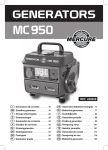

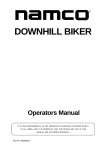
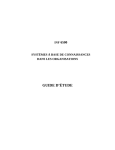
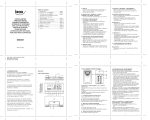

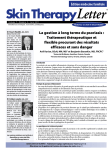
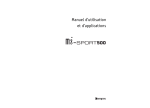
![Safyre TPlus [manual]](http://vs1.manualzilla.com/store/data/006303467_1-794d0cd6b6eca55a15e3ca04cec7e3e1-150x150.png)
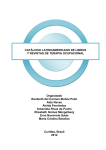
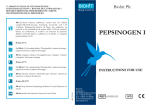


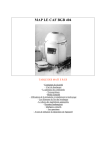


![Stratone [manual]](http://vs1.manualzilla.com/store/data/006291418_1-d5e9257404d9e914efddec8652db1907-150x150.png)
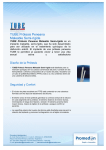
![ARGUS [manual]](http://vs1.manualzilla.com/store/data/006297667_1-37ceb2e2b18eaf6210c0b5707d5b4a5d-150x150.png)
